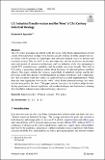U.S. Industrial Transformation and the “How” of 21st Century Industrial Strategy
Author(s)
Reynolds, Elisabeth B.
Download10842_2024_Article_420.pdf (595.3Kb)
Publisher with Creative Commons License
Publisher with Creative Commons License
Creative Commons Attribution
Terms of use
Metadata
Show full item recordAbstract
Abstract
The U.S. policy paradigm has shifted in the first years of the Biden Administration toward a more robust industrial strategy. Over the next decade, trillions of public and private-sector dollars will be invested in technologies and industries deemed critical to national and economic security. This sets the U.S. on a new trajectory, one that accelerates the development and growth of innovative technologies and key industries while also attempting to rebuild U.S. manufacturing capabilities and the middle class more broadly. This shift in U.S. policy is generating significant debate about the merits of industrial policies and their efficacy. This paper outlines the promises and pitfalls of industrial strategy and the key provisions in the three pieces of recent legislation including “guardrails” and “conditionalities” that are meant to put the country on a path toward successful implementation. While there has been significant focus on the “what” of the Biden industrial strategy, less attention has been paid to the “how.” This paper reviews the criteria by which to judge the how, the key provisions of the new legislation, and broader challenges and limitations to meeting all of the Biden Administration industrial strategy objectives.
Date issued
2024-04-11Department
Massachusetts Institute of Technology. Department of Urban Studies and PlanningPublisher
Springer Science and Business Media LLC
Citation
Journal of Industry, Competition and Trade. 2024 Apr 11;24(1):8
Version: Final published version
ISSN
1566-1679
1573-7012
Keywords
Economics and Econometrics